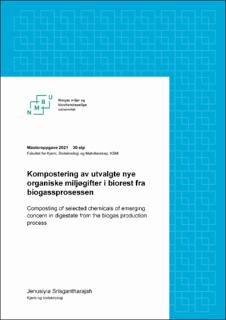| dc.contributor.advisor | Kallenborn, Roland | |
| dc.contributor.advisor | Eggen, Trine | |
| dc.contributor.advisor | Bergersen, Ove | |
| dc.contributor.author | Srisgantharajah, Jenusiyia | |
| dc.date.accessioned | 2022-01-04T20:02:36Z | |
| dc.date.available | 2022-01-04T20:02:36Z | |
| dc.date.issued | 2021 | |
| dc.identifier.uri | https://hdl.handle.net/11250/2836041 | |
| dc.description.abstract | The aim of this research was to carry out an established thermophilic-composting experiment to investigate the degradation of five different chemicals of emerging concern (CECs), namely Carbamazepine (CAR), Metoprolol (MTP), Octocrylene, Tris (1,3-dichloro-2-propyl) phosphate (TCPP) and Losartan. Bio-residue was used as a substrate and inoculated with thermophilic microorganisms on a structural material (wood from sawdust use). In the composting method, six Dewar-containers and a gas analyzer were used. The latter measured the concentrations of O2-gas electrochemically, while CO2- and CH4-gas were measured with an infrared sensor. In the composting mass, the temperature and gas measurements were monitored to follow the microbial activity. The six reactors were stopped based on little microbial activity after day 3, day 6, day 9, day 13, day 19 and day 32, respectively. The samples for the respective days were extracted with solid phase extraction, separated by reversed-phase liquid chromatography on a Agilent 1200 high-resolution liquid chromatograph and quantified on a 6490 QqQ LC-MS / MS (triple quadrupole instrument).
The composting experiment was considered successful according to the following achieved criteria: (1) good mixing ratio in each Dewar-container between digestate and chopping wood (635 g / 247 g (w/w)) in the starting mixture with 40 % - 65 % moisture, (2) consistent O2 levels of > 5 % in the pore spacing of the compost mass throughout the process, (3) low CH4 emissions (measured to < 1,7 % for all Dewar-containers) and (4) good temperature development through both the mesophilic (40 oC) and thermophilic phase (45 oC - 63,5 oC). The analytical method was found suitable for quantifying all substances except for LOS. One of the most important findings in the composting experiment was that the initial concentrations of OCT and MTP were reduced to below their detection limits (LOD) after day 6 and day 13, respectively. The initial concentrations of TCPP were, however, not reduced below its LOD. Still, consecutive trend measurements of TCPP indicate that further reduction could be expected if the reactor time (day 32) had been extended. The variations in oxygen consumption throughout the composting period may indicate that the aerobic microorganisms switch between carbon sources, and the CECs was further suspected to cause different oxygen consumption levels. During the higher microbial activity period, CAR had one of the fastest reduction rates among the target compounds, regardless of its stability. Still, CAR turned out to accumulate in the composting material in the end of the composting process. | en_US |
| dc.description.abstract | Målsettingen for denne masteroppgaven var å utføre et etablert termofilt komposteringsforsøk for å undersøke nedbrytningen av fem ulike organiske miljøgifter som inkluderer Karpamazepin (CAR), Metoprolol (MTP), Oktokrylen, Tris (1,3-diklor-2-propyl)fosfat (TCPP) og Losartan. Biorest ble brukt som substrat og inokulert med termofile mikroorganismer sittende på strukturmateriale av typen hoggflis fra sagflisbruk. I komposteringsmetoden ble det benyttet seks Dewar-reaktorer og en gassanalysator (GA 2000). GA 2000 målte konsentrasjonene av O2-gass elektrokjemisk, og CO2- og CH4-gass ble målt med en infrarød sensor. I komposteringsmassen ble temperatur- og gassmålingene overvåket for å følge den mikrobielle aktiviteten, og reaktorene ble stoppet basert på lite mikrobiell aktivitet etter henholdsvis dag 3, dag 6, dag 9, dag 13, dag 19 og dag 32. Prøvene til de respektive dagene ble ekstrahert i en fast-fase ekstraksjon, separert med omvendtfase væskekromatografi på en Agilent 1200 høyoppløselig væskekromatograf og kvantifisert på en 6490 QqQ LC-MS/MS (trippel kvadrupol instrument).
Komposteringsforsøket ble vurdert som godt basert på følgende oppnådde kriterier: (1) godt blandingsforhold i hver Dewar-reaktor mellom biorest og hoggflis (635 g / 247 g (w/w)) i startblandingen med 40 % - 65 % fuktighet, (2) opprettholdelse av > 5 % O2-konsentrasjon i kompostmassens porerom gjennom prosessen, (3) lave utslipp av CH4 (målt til < 1,7 % hos alle Dewar-reaktorene) og (4) god temperaturutvikling gjennom både mesofilfasen (40 oC) og termofilfase (45 oC - 63,5 oC). Analysemetoden var egnet til å bestemme alle stoffene unntatt LOS. Ett av de viktigste funnene i komposteringsforsøket var at konsentrasjonene til OCT og MTP ble redusert til under deteksjonsgrensen (LOD) etter henholdsvis dag 6 og dag 13. TCPP ble derimot ikke redusert til under LOD, men målinger av stoffet tyder på at det ville blitt redusert ytterligere dersom reaktoren (dag 32) hadde gått noe lengre. Variasjonene i oksygenforbruk gjennom komposteringsperioden kan peke mot at de aerobe mikroorganismene skiftet mellom karbonkilder, og det mistenkes at de målte miljøgiftene kan ha ført til ulike oksygenforbruk. Under perioden med høy mikrobiell aktivitet var CAR blant stoffene som hadde raskest reduksjonsrate, uavhengig av stoffets stabilitet. Samtidig akkumulerte CAR i komposteringsmaterialet mot slutten av komposteringsprosessen. | en_US |
| dc.language.iso | nob | en_US |
| dc.publisher | Norwegian University of Life Sciences, Ås | en_US |
| dc.rights | Attribution-NonCommercial-NoDerivatives 4.0 Internasjonal | * |
| dc.rights.uri | http://creativecommons.org/licenses/by-nc-nd/4.0/deed.no | * |
| dc.title | Kompostering av utvalgte nye organiske miljøgifter i biorest fra biogassprosessen | en_US |
| dc.title.alternative | Composting of selected chemicals of emerging concern in digestate from biogas production process | en_US |
| dc.type | Master thesis | en_US |
| dc.description.localcode | M-KB | en_US |

